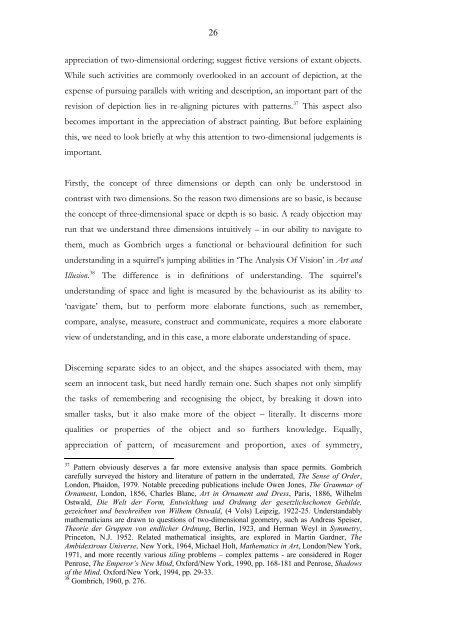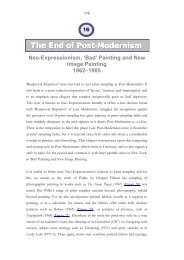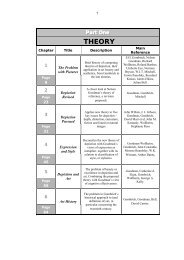Download - depictionandpainting.net
Download - depictionandpainting.net
Download - depictionandpainting.net
You also want an ePaper? Increase the reach of your titles
YUMPU automatically turns print PDFs into web optimized ePapers that Google loves.
26<br />
appreciation of two-dimensional ordering; suggest fictive versions of extant objects.<br />
While such activities are commonly overlooked in an account of depiction, at the<br />
expense of pursuing parallels with writing and description, an important part of the<br />
revision of depiction lies in re-aligning pictures with patterns. 37 This aspect also<br />
becomes important in the appreciation of abstract painting. But before explaining<br />
this, we need to look briefly at why this attention to two-dimensional judgements is<br />
important.<br />
Firstly, the concept of three dimensions or depth can only be understood in<br />
contrast with two dimensions. So the reason two dimensions are so basic, is because<br />
the concept of three-dimensional space or depth is so basic. A ready objection may<br />
run that we understand three dimensions intuitively – in our ability to navigate to<br />
them, much as Gombrich urges a functional or behavioural definition for such<br />
understanding in a squirrel’s jumping abilities in ‘The Analysis Of Vision’ in Art and<br />
Illusion. 38 The difference is in definitions of understanding. The squirrel’s<br />
understanding of space and light is measured by the behaviourist as its ability to<br />
‘navigate’ them, but to perform more elaborate functions, such as remember,<br />
compare, analyse, measure, construct and communicate, requires a more elaborate<br />
view of understanding, and in this case, a more elaborate understanding of space.<br />
Discerning separate sides to an object, and the shapes associated with them, may<br />
seem an innocent task, but need hardly remain one. Such shapes not only simplify<br />
the tasks of remembering and recognising the object, by breaking it down into<br />
smaller tasks, but it also make more of the object – literally. It discerns more<br />
qualities or properties of the object and so furthers knowledge. Equally,<br />
appreciation of pattern, of measurement and proportion, axes of symmetry,<br />
37 Pattern obviously deserves a far more extensive analysis than space permits. Gombrich<br />
carefully surveyed the history and literature of pattern in the underrated, The Sense of Order,<br />
London, Phaidon, 1979. Notable preceding publications include Owen Jones, The Grammar of<br />
Ornament, London, 1856, Charles Blanc, Art in Ornament and Dress, Paris, 1886, Wilhelm<br />
Ostwald, Die Welt der Form, Entwicklung und Ordnung der gesetzlichschonen Gebilde,<br />
gezeich<strong>net</strong> und beschreiben von Wilhem Ostwald, (4 Vols) Leipzig, 1922-25. Understandably<br />
mathematicians are drawn to questions of two-dimensional geometry, such as Andreas Speiser,<br />
Theorie der Gruppen von endlicher Ordnung, Berlin, 1923, and Herman Weyl in Symmetry,<br />
Princeton, N.J. 1952. Related mathematical insights, are explored in Martin Gardner, The<br />
Ambidextrous Universe, New York, 1964, Michael Holt, Mathematics in Art, London/New York,<br />
1971, and more recently various tiling problems – complex patterns - are considered in Roger<br />
Penrose, The Emperor’s New Mind, Oxford/New York, 1990, pp. 168-181 and Penrose, Shadows<br />
of the Mind, Oxford/New York, 1994, pp. 29-33.<br />
38 Gombrich, 1960, p. 276.




